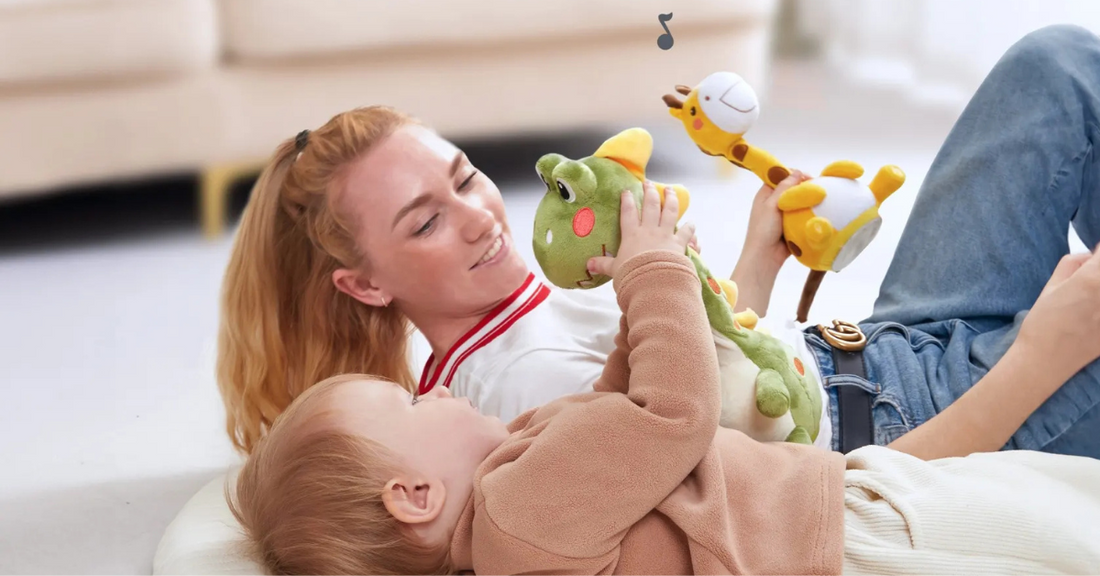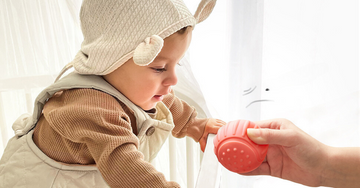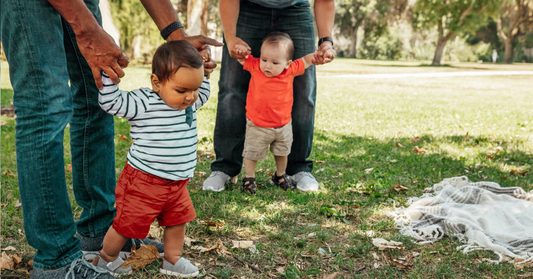Интерактивные игрушки для малышей: поддержка развития от новорожденного до малыша

Интерактивные игрушки — это не просто развлечение; они предназначены для того, чтобы вовлекать детей в процесс, способствующий их развитию. В этой статье мы рассмотрим, что делает эти игрушки полезными, на какие характеристики следует обращать внимание и как выбрать лучшие варианты для каждого периода младенчества. Читайте дальше, чтобы узнать, почему интерактивные детские игрушки необходимы для раннего обучения и развития!
Что такое интерактивные детские игрушки? (И зачем нам нужны игрушки для младенцев?)
Интерактивные игрушки предназначены для реагирования на действия ребенка, например, игрушка, которая загорается при прикосновении или играет музыку при нажатии кнопки. Эти игрушки делают игру более энергичной и интересной, позволяя детям связывать свои действия с результатами. Этот контакт имеет решающее значение для развития когнитивных навыков, моторики и сенсорного восприятия.
Зачем нужны игрушки для развития младенцев?
В течение первых месяцев и лет жизни младенцы быстро приобретают навыки во всех сферах жизни: от координации движений до решения проблем. Интерактивные детские игрушки Улучшить игру, смешивая удовольствие с запланированными обучающими мероприятиями, позволяя новорожденным открывать мир в своем собственном темпе. Интересно, когда дети начинают играть с игрушками? Узнайте в нашей статье Когда дети начинают играть с игрушками?
Как интерактивные игрушки способствуют развитию ребенка
Когнитивное развитие с помощью игрушек
Игрушки для когнитивного развития Цель — стимулировать мышление ребенка. Они побуждают детей исследовать причины и следствия, улучшают память и даже знакомят с языком через звуки и слова. Интерактивный игрушки для развития познавательных способностей ребенка научить детей распознавать закономерности, реагировать на приказы и решать основные проблемы. Например, игрушки для развития познавательных способностей младенцев Игрушки, издающие звуки при прикосновении, способствуют развитию слуховых способностей, тогда как игрушки с различной текстурой стимулируют сенсорное исследование.
Физическое развитие через игру
Интерактивные игрушки способствуют физическому развитию, особенно мелкой и крупной моторики. Активные игрушки для помещений, такие как коврики для ползания, игрушки-толкатели и игровые центры, помогают новорожденным развивать силу, координацию и контроль. По мере роста младенцы могут экспериментировать с игрушками, требующими более сложных действий, например складывание игрушек или катящиеся шары, которые отлично подходят для интерактивные игрушки.
Развитие сенсорных ощущений с помощью забавных интерактивных игрушек
Сенсорная стимуляция важна в младенчестве, поскольку она помогает детям воспринимать окружающую среду через осязание, зрение и слух. Веселые интерактивные игрушки в различных цветах, текстурах и звуках позволяют младенцам заниматься сенсорным обучением в безопасной среде. Музыкальные игрушки, например, могут помочь развить чувство ритма и улучшить слуховую обработку. По мере того, как младенцы больше знакомятся с сенсорными аспектами, они учатся обрабатывать и реагировать на различные стимулы, что способствует их когнитивному и эмоциональному развитию.
Преимущества по возрастным группам
Для младенцев и малышей: Интерактивные игрушки , включающие тихую музыку, красочные огни и текстуры, идеально подходят для младенцев, поскольку они помогают им развивать навыки слуха и сенсорное восприятие.
Для детей постарше (3-4 года): Игрушки для ролевых игр, такие как интерактивные чучела животных, помогают младенцам развивать социальные навыки, такие как эмпатия и сострадание, которые важны, когда они начинают понимать, что чувствуют другие. Такие игрушки могут формировать чувство ответственности.

Для дошкольников: По мере того, как дети растут, c с продвинутыми движениями, такими как игрушки с дистанционным управлением, способствуют социальным связям и сотрудничеству. Эти игрушки также помогают детям развивать мелкую моторику, пространственное восприятие и совместную игру.

Преимущества интерактивных игрушек по сравнению с традиционными игрушками
Как интерактивные, так и традиционные игрушки способствуют развитию ребенка, но интерактивные игрушки, такие как интерактивные детские игрушки, имеют явные преимущества. Традиционные игрушки часто имеют меньше интерактивных аспектов, что ограничивает их сенсорную и когнитивную стимуляцию. В отличие от этого, игрушки для раннего обучения предлагать практические занятия, которые активно вовлекают детей, развивая память, координацию и слуховые способности.
Главные особенности, на которые следует обратить внимание при выборе интерактивных детских игрушек
При выборе интерактивные детские игрушкиважно искать ключевые особенности, которые обеспечивают безопасность и стимулируют развитие:
- Прочность: Выбирайте игрушки, изготовленные из высококачественных материалов, которые выдерживают ежедневное использование.
- Безопасность: Убедитесь, что все материалы нетоксичны, подходят для возраста ребенка и не содержат мелких деталей.
- Срок службы батареи: Для аккумуляторных батарей интерактивные игрушки, ищите варианты, которые экономят энергию и имеют безопасные отсеки для батареек.
- Сенсорные элементы: Выбирайте игрушки со светом, звуками или текстурами, так как они удерживают интерес ребенка и способствуют сенсорному развитию.
- Легкость очистки: Младенцы часто исследуют мир руками и ртом, поэтому выбирайте игрушки, которые легко дезинфицировать и содержать в гигиене.
Интерактивные игрушки и знаки, соответствующие возрасту: ваш ребенок готов
0-3 месяца: Мягкие игрушки с мягкими огнями или звуками идеально подходят для новорожденных. Интерактивные игрушки для младенцев, такие как погремушки или сенсорные коврики, обучают причинно-следственным связям в расслабляющей манере.
4-6 месяцев: В этом возрасте дети готовы к более тактильным игрушкам, которые реагируют на их движения. Игрушки, которые играют простую музыку, способствуют развитию слуха и вовлечению.
7-12 месяцев: Игрушки для ползания, игровые центры и др. интерактивные игрушки которые способствуют развитию подвижности и координации, идеально подходят для младенцев, которые становятся более подвижными и любознательными.
12+ месяцев: По мере того, как малыши растут, они начинают ценить игрушки, которые стимулируют решение проблем, изобретательность и развитие речи, например, интерактивные плюшевые животные или игровые наборы с говорящими компонентами.
Определение готовности вашего ребенка к интерактивным игрушкам.
По мере того, как новорожденные начинают интересоваться светом, музыкой или движением, может быть целесообразно знакомить их с более сложными играми. интерактивные детские игрушки. Младенцы часто проявляют любопытство, тянутся к предметам, смеются при звуках и реагируют на цвета, что свидетельствует о том, что они готовы исследовать игрушки, предназначенные для развития их растущих навыков.
Как выбрать лучшую интерактивную игрушку для вашего ребенка
При выборе интерактивные детские игрушки, отдайте приоритет безопасности, качеству и преимуществам развития.
- Безопасность: Убедитесь, что игрушки соответствуют возрасту и не содержат токсичных и опасных материалов.
- Прочность: Выбирайте игрушки, которые подходят для активных игр.
- Легкость очистки: Выбирайте игрушки, которые легко протирать, чтобы соблюдать гигиену.
- Советы родителям: Разнообразие игровых интерактивных и автономных игровых занятий, помогающих новорожденным развивать социальные и самостоятельные способности.
Лучшие интерактивные игрушки для младенцев и малышей

Ходячая игрушка для кошек
Электронная ходячая плюшевая игрушка-кошка обеспечивает увлекательный и поучительный опыт для детей. Она ходит, виляет хвостом, поет и имитирует сосание рыбы, развлекая детей часами. Каждая игрушка включает бонусные подарки, такие как ватный шарик, миниатюрная рыбка и кошачий шарф, что добавляет разнообразия в игру. Прикрепленная миска для еды и поводок позволяют детям притворяться, что они заботятся о своей кошке, что способствует развитию ответственности и сочувствия. Эта игрушка не только развлекает, но и стимулирует воображение, двигательные способности и сенсорное развитие.
Обзор: «Этот котенок такой мягкий и милый! Каждый раз, когда моя собака лает, он мяукает и делает такие милые вещи. Он сделан очень хорошо. Недешевая работа. Он радует моих внуков, когда они приходят в гости».
«Моя племянница и дочь получили этих кошек на Рождество. Когда я вставляла батарейки, я была одна в другой комнате, кошка залаяла, а затем начала издавать обычные кошачьи звуки. Вернувшись в комнату, где была моя семья, чтобы дать девочкам поиграть с их кошками, я сказала всем: «Кошка лает? Я пыталась заставить ее лаять снова, но это было как попало. Никто мне не верил, и на некоторое время это стало шуткой, что я слышу что-то. Затем это произошло, когда все были в комнате, кошка залаяла! «О боже, она лает!» — воскликнули все. Кто теперь сумасшедший? Я или лающий кот?? За исключением случайного лая, кошки работают хорошо. Наши девочки любят своих лающих кошек. Трудно оценить подарочность, потому что некоторые могут не захотеть кошку, которая лает. Мы думаем, что это забавно, а наши девочки любят кошек, так что я не против. Но если лающий кот вас раздражает, возможно, не покупайте его».
Игрушка для выгула собак
Модернизированная в 2023 году электронная игрушка для домашних собак предлагает интерактивный и реалистичный опыт, включающий новое действие облизывания, которое добавляет реалистичности. Эта очаровательная гуляющая собака ростом 9 дюймов поставляется с поводком с дистанционным управлением, собачьим мячом, ошейником, биркой с именем, аксессуарами для кормления (миской, бутылочкой и резиновой костью) и многим другим. Благодаря таким функциям, как ходьба, лай, виляние хвостом, покачивание головой и пение, эта игрушка вовлекает детей в веселую, развивающую игру. Изготовленная из мягких, приятных для кожи материалов, она идеально подходит для детей с аллергией. Отличный подарок для детей от 2 лет и старше, она идеально подходит для дней рождения, Рождества и других особых случаев.
Обзор: «Повторяет четко и настолько громко, насколько это возможно, все, что вы ему говорите. Мой двухлетний сынишка просто обожает его, поскольку он произносит слова, которые учит, каждый раз, когда он его повторяет, он находит это таким забавным, что это был отличный подарок на день рождения двухлетнему ребенку».
«Как я уже говорил, моя внучка все еще играет с ним, хотя и не так много, как поначалу. Мне понравилось, что звуки были достаточно реальными. Сначала я немного волновался, потому что видел, как разные собаки издавали больше звуков, похожих на кошачьи.Очень приятный на ощупь, а те датчики, которые заставляют его реагировать, когда его обнимаешь, моя внучка освоила на удивление быстро».

Увеличение игровой ценности: советы по увлекательному игровому времени
Чтобы максимально эффективно использовать игрушки вашего ребенка:
- Регулярно меняйте игрушки: Чередуя игрушки, вы поддерживаете интерес ребенка и делаете игру более интересной.
- Поощряйте самостоятельную игру: Предоставление детям пространства для самостоятельных игр способствует формированию у них уверенности в себе и стремлению к исследованию.
- Простые игры: Предложите ребенку игры, такие как «прятки» или «называние предметов», чтобы стимулировать развитие речи и памяти с помощью игрушек.
Часто задаваемые вопросы об интерактивных детских игрушках
- Когда дети начинают играть с игрушками? Обычно дети начинают исследовать игрушки в возрасте 2–3 месяцев и становятся более заинтересованными по мере улучшения координации движений рук и глаз.
- Как игрушки для когнитивного развития могут улучшить обучение? Игрушки, развивающие когнитивные навыки, помогают младенцам изучать причинно-следственные связи, память и основы языка.
- Способствуют ли интерактивные детские игрушки развитию? Хотя интерактивные игрушки и не являются необходимыми, они обеспечивают дополнительные сенсорные и когнитивные преимущества.
- Как играть с игрушками, которые способствуют установлению связей? Младенцы приобретают языковые навыки и навыки распознавания через игру, которая включает в себя разговор, указание предметов и называние их.







0 комментарии